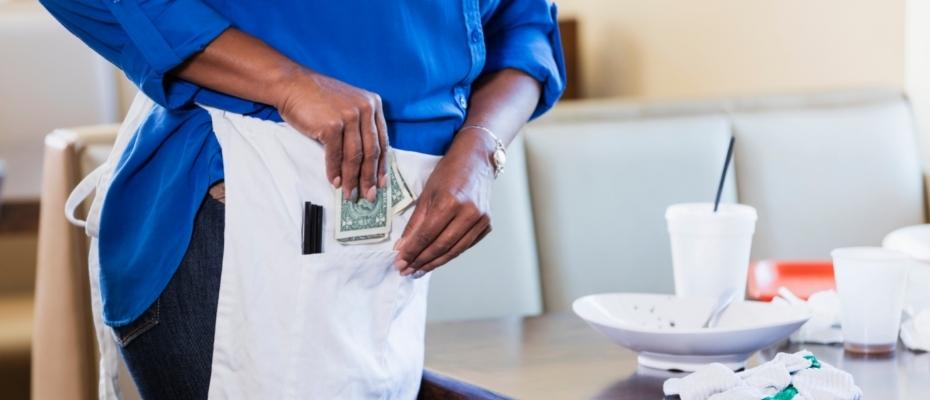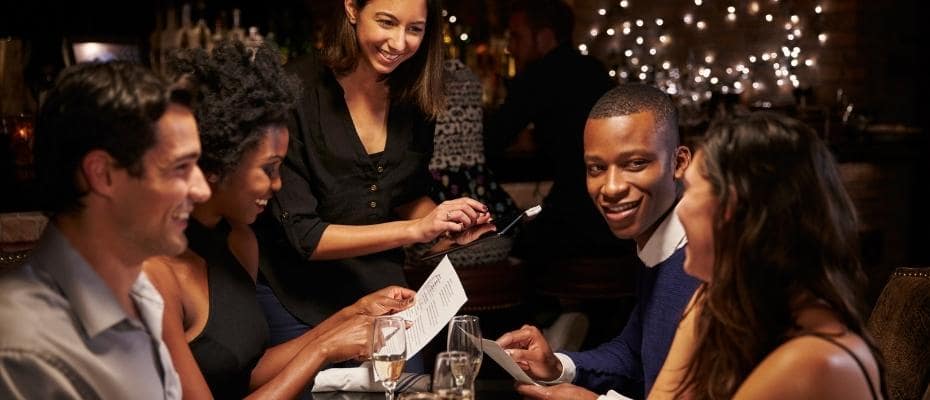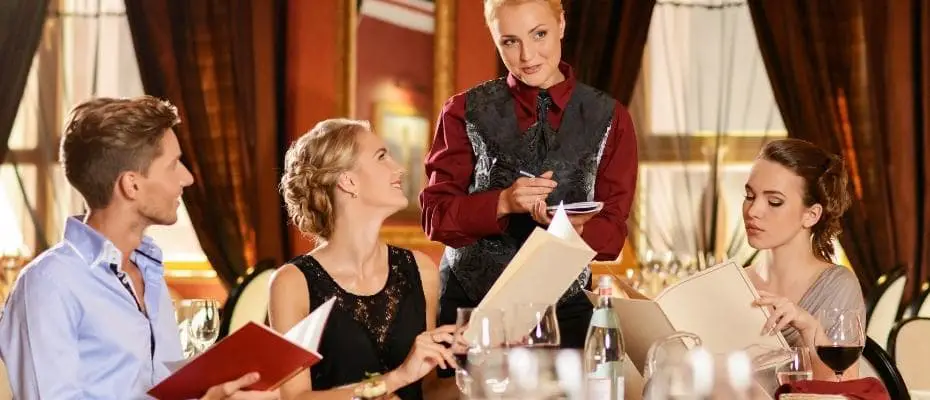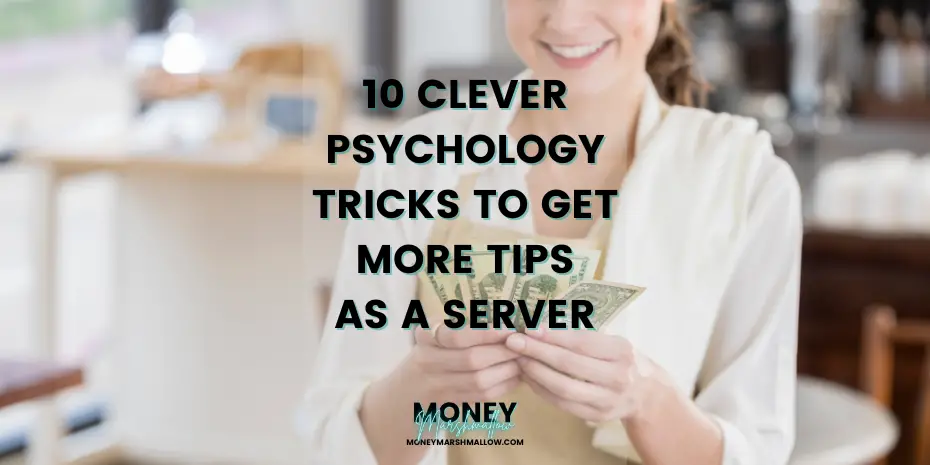We have previously covered psychological tricks restaurants use to make you spend more money – but did you know that the waiting staff can also use psychological tricks to get more tips?
For servers looking to boost their tips to make more money, or for curious customers wanting a peek behind the curtain, here are ten psychology tricks based on consumer behaviour science to keep in mind.
How to use psychology to increase your tips
Tipping norms vary hugely depending on the country. Whether customary (e.g. US & Canada) or an extra gesture for excellent service (most countries in Europe), it’s universally known that the key to receiving higher tips is to create an environment that predisposes customers to be more generous. This is where human psychology and sales psychology tricks come in! The following psychology tricks for more tips subtly persuade customers to leave more generous tips.

1. Introduce yourself
Restaurant servers sometimes introduce themselves by name when greeting their customers. This can make them seem friendly and polite. It’s also likely to make the customer feel more empathy for the server. Both effects should increase tips.
A study done in southern California has also proven this. In the study, half of the waiting staff greeted their tables with their name and the other half didn’t – and the difference in tips was significant. The group who introduced themselves received an average tip of 23% compared to 15% for those who didn’t. The key takeaway here; if you want to earn bigger tips, you first must introduce yourself to your table!
2. Use positive body language
Studies have also shown that nonverbal communication can influence how much servers get tipped.
While introducing yourself is important, simply providing customers with your name is not sufficient. Your introduction should be accompanied by a genuine smile and eye contact. Smiling is a well-known tactic of social influence. Research has confirmed the cultural wisdom regarding smiling; smiling people are perceived as more attractive, sincere, sociable, and competent than unsmiling people. Therefore, servers who smile receive larger tips. A study from 1978 found that smiling more often could even double the tip for the server.
But what about how close servers stand from customers? A French study looked specifically at that. Waitresses at different restaurants stood at varying distances from customers while taking their orders. Interestingly, customers who were seated alone and had the waitress stand closer to them were more likely to tip, and their tips were even bigger! This suggests that personal space, and the chance for more interaction, can play a role in tipping behavior. However, it’s important to remember that these results might not apply everywhere. People from different cultures have different comfort levels with personal space. What feels friendly in one place might feel intrusive in another.

3. Squat next to the table
In 1993, Cornell University studied the effect of server posture (standing vs. squatting) on the size of tips left by restaurant customers. While server posture didn’t affect bill size, it did affect tipping. Interestingly, squatting down next to the tables increased servers’ tips by nearly 25%. So why does this work?
While the study doesn’t indicate what psychological processes underlie this effect, the researchers had a few theories:
- When a server squats down to talk to customers, it might make them feel more excited or engaged, which could lead to bigger tips.
- Having a server squat down may elevate customers’ moods and this positive effect may increase tipping.
- Servers seem friendlier when they squat down and this enhanced friendliness leads customers to tip the server more.
4. Repeat orders back to your customer
After making your order in a restaurant, it’s common for a server to repeat your order. But many customers or even servers don’t know that this can be a psychological trick to get more tips.
In fact, psychological experiments have shown that when servers repeated an order back to customers their tips increased by over 68%. The reason why this leads to a better tip is attributed to two key factors. First, confirming the order demonstrates the server’s competence and attention to detail, reassuring the customer. Second, repeating the order leverages a fascinating psychological phenomenon called the chameleon effect. As described in Chris Voss’s book Never Split the Difference, subtly mirroring someone’s behaviour, like repeating their words, can build rapport and positive feelings. By echoing the customer’s order, the server unconsciously creates a sense of connection with the customer, leading to a more enjoyable experience and potentially a bigger tip.
5. Add a gentle touch
Touching is a powerful form of interpersonal behaviour that can communicate affection, aggression, dominance, and other meanings, depending on the context. In commercial settings, casually touching customers has been shown to increase the time they spend in a store and the amount of money they spend.
Studies also suggest that being touched may also increase the tips that customers leave their servers. According to one study, customers left an average tip of 12% when not touched, 14% when touched once on the shoulder, and 17% when touched twice on the palm.
Subsequent research by other investigators has demonstrated that casually touching customers increases the tips of both male and female servers and that the effect is strongest when servers touch the female members of dining parties.
These results sound promising for servers looking for the best psychology tricks to get more tips. However, it’s worth noting that many of these studies were conducted in the US in the 70s and 80s and might not always be appropriate in today’s world. It’s therefore good to assess the situation and be mindful of different cultures before you touch customers.
Related: 14 Sneaky Retail Psychology Tricks That Make You Spend More
6. Treat them to a small token of appreciation
Expressing your gratitude with a thoughtful gesture is another brilliant way servers use to increase tips, thanks to the reciprocity principle. Reciprocity is the belief that when receiving something from somebody, people are predisposed to return the favour. Sociologists have confirmed that reciprocation is a powerful motivator across all human cultures.
It turns out that you and I probably vastly underestimate the psychological process behind mint-giving. However, one research showed that when servers gave customers a sweet with the bill, tips rose an average of 3%. But the study also revealed that if the server gave each guest two sweets, the tips jumped up 14%. So if servers give their customers something as small as some sweets or mints, the guests are more likely to return the courtesy with higher tips.
7. Compliment customers' order choices
Research published in the Journal of Applied Social Psychology in 2007 analysed the effect of complimenting customers’ orders on tipping behaviour in restaurants. In the study, servers were instructed to compliment customers after receiving an order by saying “You made a good choice!”. The servers who expressed verbal approval to their guests received larger tips than those who did not.

8. Use the power of the recency effect
The recency effect is the principle that people are most influenced by what they have seen or heard last. Consequently, a server’s behaviour after the meal can shape the customers’ perception of the server. It can therefore impact the size of the tip the server will receive. For instance, research from 2006 has shown that waiting staff can increase their tip percentages by writing “Thank you” or by drawing a smiley face on the back of a customer’s bill.
In one upscale restaurant, writing a friendly message about an upcoming special event on the back of the check increased tips by 3%. Positive weather forecasts can also be a charm. Another study found that mentioning good weather on the check led to a similar 3 percent tip bump. However, beware of negativity – mentioning bad weather actually decreased tips compared to no message at all. So, keep it positive and add a touch of personalisation to your check presentation.
When servers show their appreciation for their customers just before they decide upon the amount of the tip, the customer is primed to think highly of the server and reciprocate appreciation in the form of an improved tip.
9. Choose the right colours
Many studies have documented how colours influence consumer behaviour. A handful of studies have also looked at the impact of colours on the size of tips. They found that the size of tips can indeed be influenced by the colours the waitstaff wear:
- Hair: A study from 2012 found that waitresses with blond hair received more tips than waitresses with dark or red hair. However, this was only true with male guests. Waitresses’ hair colour did not affect females’ tipping behaviour.
- Clothing: Another study found that waitresses wearing red received more tips but only with male customers. The waitresses’ colour did not affect female patrons’ tipping behaviour.
- Lipstick: Even the impact of the colour of lipstick on tips has had its own research. The results showed that lipstick, particularly red lipstick, was associated with larger tips – but again, just from male customers.
Researchers explain the above results are down to the increase in attractiveness and femininity of waitresses wearing certain colours. Interestingly, attractiveness had no effect on tip amounts for male servers from either male or female customers.
When it comes to tipping, colours have other roles too. For example, exposure to gold in a restaurant (e.g. gold bill folders or tablecloths) can make you leave a bigger tip. This might be because the colour gold has long signified something precious and superior. Therefore, the exposure to gold makes customers feel like they’re in a restaurant that caters to high-status people. And when people feel like they’re wealthier, they more inclined to show their wealth with larger tips.
10. Use credit card logos to encourage spending
Research suggests a subtle environmental cue can positively influence tipping behaviour: the presence of a credit card logo on the bill tray. A credit card logo can nudge customers to tip slightly higher – studies found an average increase of 4%. Psychologists believe it triggers an association with free spending, making customers more comfortable leaving a larger tip. So, consider using that handy tray with the credit card logo next time you present the bill. It’s a subtle yet effective way to boost your income potentially.
Related: Credit card psychology: Do credit cards make you spend more?
Conclusion: Tip psychology tricks
Psychological research on tipping has shown that servers can earn larger tips when they employ a few simple techniques. From introducing themselves by name to writing “thank you :)” on the backs of bills, there are various tip psychology tricks to get more tips. And if they are ineffective, customers will unlikely recognise that the techniques were used on them – unless they’ve read this post of course!
The golden rule for servers to get higher tips is to be likeable and make customers feel good about themselves. The more customers like their servers, the higher the more generous they are likely to be with tipping.


Interesting! As a previous server I can definitely attest to these tips but I’m a little sad to hear I might have gotten even more if I dyed my hair blonde lol
Never thought about that before… But now when I read it, I realised it’s true.
Excellent soft skill tips. The one on squatting was new to read and unknown.
I’ve noticed a few of these actions before but I always thought it was just great customer service. Thanks for sharing!
I will pay attention next time to see who apply these psychology tricks.
I’ve been serving for 20+ years and my golden rule is serve someone the way you would like to be served if you were in their place.